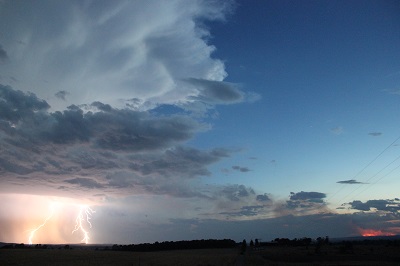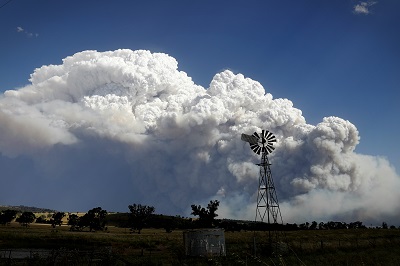
Researchers say a better understanding of the dangerous yet surprisingly common phenomenon of wildfires triggering supercell thunderstorms could reduce risk to life and property.
A thunderstorm generated by a New South Wales wildfire reached a height of 12.7 kilometres, according to an analysis involving University of Queensland, Bureau of Meteorology and Monash University researchers.
UQ Atmospheric Observations Research Group leader Professor Hamish McGowan said the fire‐generated thunderstorm also had a large core of rotating winds, indicating that it had indeed developed into a supercell thunderstorm.
“This is the most dangerous type of thunderstorms, generally associated with extremely damaging winds, large hail and lightning.
“Such a storm in proximity to a severe fire can pose a dire risk to firefighters and residents in the affected areas, and the ability to forecast such a risk could make a significant difference to safety.”
The Sir Ivan Dougherty wildfire impacted 55,000 hectares of land in New South Wales in February 2017.
“It occurred in extreme conditions and was affected by the passage of a cold front over the wildfire,” Professor McGowan said.

near the local town of Coolah, looking to the southeast (Credit: Alex Ellinghausen).
“We could show that the cold front’s increase in atmospheric moisture, combined with changes in fire behaviour at that time, triggered the wildfire‐induced thunderstorm.
With more extreme weather predicted to result from climate change, the team’s findings highlighted the importance of combining weather radar and on-the-ground meteorological observations, providing insights into this fire‐atmosphere coupling phenomenon.
“These observations are essential, helping us better build an understanding of extreme wildfire events, which could help improve fire behaviour predictions,” Professor McGowan said.
Researchers used weather radar to investigate the dynamics of large plumes of heat, smoke and burning debris – known as pyrometeors – lofted above bushfires.
“These radar observations are then supported with a wide range of other meteorological data from weather stations, weather balloons and weather satellites,” Professor McGowan said.
“We also used observations of a fire’s behaviour made by firefighting personnel and local residents to further expand our understanding of fire–atmosphere interactions.”
Professor McGowan said the analysis provided information to assist with bushfire management strategies.
The research is published in JGR Atmospheres (DOI: 10.1029/2018JD029986).
Media: Professor Hamish McGowan, h.mcgowan@uq.edu.au, +61 458 389 933; Dominic Jarvis, dominic.jarvis@uq.edu.au, +61 413 334 924.



